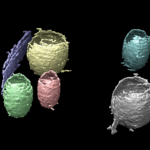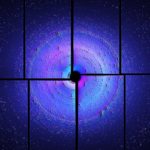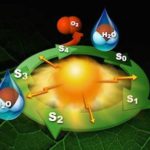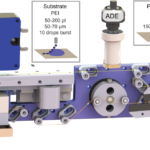After decades of effort, scientists have revealed atomic-scale details of the water splitting step of photosynthesis, the chemical process that generates the air we breathe. The latest work adds to our understanding of photosynthesis and will aid the development of fully renewable alternative energy sources.
A Machine Learning Pipeline for Interpreting Large Tomography Datasets
A team of Berkeley Lab scientists has developed a machine-learning pipeline to facilitate segmentation of tomograms of cell membrane structures. The project was an LDRD-funded collaboration among Chao Yang from the Applied Mathematics and Computational Research Division, and Nick Sauter and Karen Davies from the Molecular Biophysics and Integrated Bioimaging (MBIB) Division.
Crystallography for the Misfit Crystals
Nicholas Sauter, a computer senior scientist in the Molecular Biophysics and Integrated Bioimaging (MBIB) Division, is co-leading a team working to provide a better way for scientists to study the structures of the many materials that don’t form tidy single crystals. Their new technique, called small-molecule serial femtosecond X-ray crystallography, or smSFX, supercharges traditional crystallography with the addition of custom-built image processing algorithms and an X-ray free electron laser (XFEL). In a paper published in Nature, the team demonstrated proof-of-principle for smSFX and reported the previously unknown structures of two metal-organic materials known as chacogenolates.
Chloro-phylling in the Answers to Big Questions
A team of scientists, including many in the Molecular Biophysics and Integrated Bioimaging Division, uncovered new details about the reaction that powers photosynthesis. Understanding this reaction could lead to world-changing advances in technology, medicine, or energy––and also gives insight into how the enzyme photosystem II produces the oxygen we breathe. Their latest work was recently published in Nature Communications and two of the authors, Vittal Yachandra and Philipp Simon, spoke with Strategic Communications about that, shooting stuff with lasers, and why they chose this field of research.
New Technique Gets the Drop On Enzyme Reactions
As part of an international collaboration, researchers at Lawrence Berkeley National Laboratory (Berkeley Lab), the Diamond Light Source synchrotron facility, and Oxford and Bristol Universities in England have developed a novel sample delivery system that expands the limited toolkit for performing dynamic structural biology studies of enzyme catalysis, which have so far mostly been limited to a small number of light-driven enzymes.
- 1
- 2
- 3
- 4
- Next Page »
Was this page useful?








